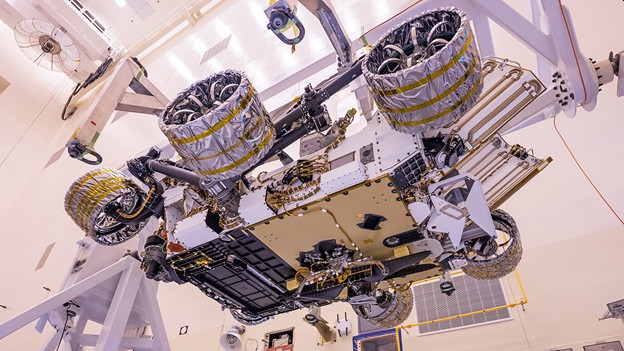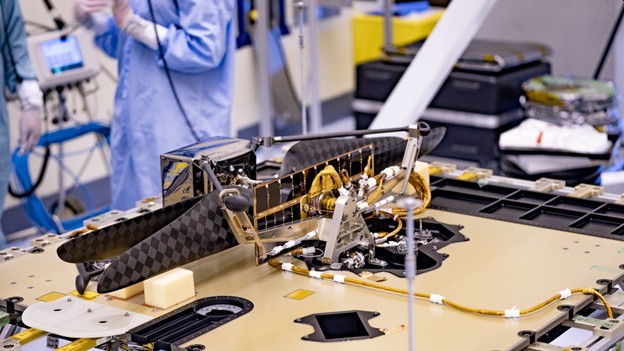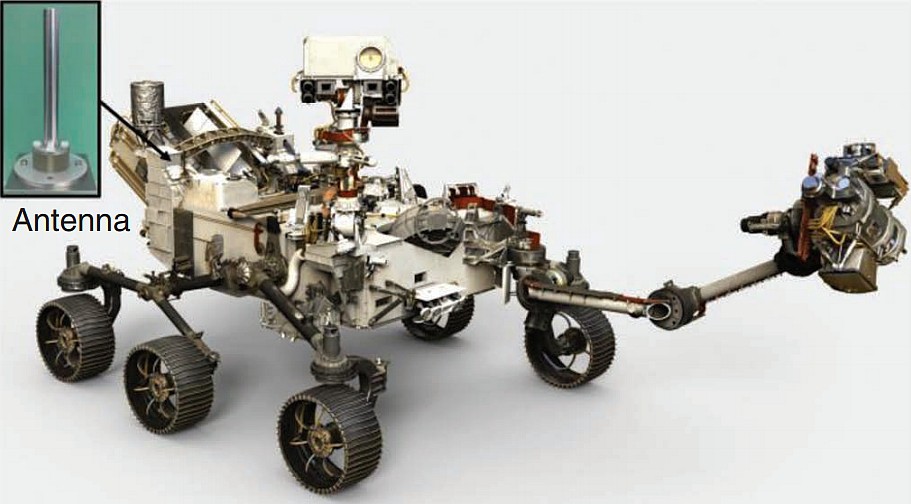
(Image from NASA)
Leonardo Da Vinci once said, “When once you have tasted flight, you will forever walk the earth with your eyes turned skyward, for there you have been, and there you will always long to return.”

The Mars 2020 Rover Perseverance with its helicopter, Ingenuity, cocooned in the lower center of the Rover getting ready to launch in July 2020 (Image from NASA-JPL-Caltech)
In my previous article on hackaday.io, entitled Mars 2020 Rover: Perseverance, I outlined the instrumentation on the Mars 2020 Rover. In this article I will highlight the Mars helicopter. Meet Ingenuity, a four pound helicopter drone with four foot diameter, twin counter-rotating, propellers.
The name ‘Ingenuity’ was submitted by an Alabama 11th grader Vaneeza Rupani, as part of NASA's "Name the Rover" contest for Mars 2020.
After landing on Mars, at the time Ingenuity is ready to fly, Perseverance will move 100 meters on the Mars surface and will perform a systems check on the helicopter. After this, the helicopter will have an initial flight test for as much as 30 days. The Mars atmosphere is very thin: less than 1% the density of the Earth’s. Once the helicopter is detached from the Rover, it will use its own solar panel, situated above its propellers, to generate its electrical power independent of the Rover. Figure 1.

Figure 1 The Mars Helicopter Ingenuity is shown here, in the assembly area at Kennedy Space Center, mounted to the bottom of the Rover (Image from NASA)
Why a drone helicopter?
Ingenuity flies pretty independently, without human control. It will take off, fly, and land with minimal commands from Earth sent in advance.
Because of the absence of global positioning systems for Mars, dead-reckoning methods like Wheel Odometry (WO) and Visual Odometry (VO) are the major sources of localization on Mars for the Rover.
Ingenuity has the ability to fly and explore larger Mars surface areas with down-facing cameras which will provide high resolution data to assist the Rover to identify small hazards like steps and pointy rocks.
Ingenuity is much faster than the Rover; however, its operation time is limited to only one 90-second flight per day due to the severe power constraints. The helicopter can fly up to 90 seconds after it takes off from the Rover’s body, to distances of about 980 feet (300 meters) at a time, and about 10 to 15 feet above the Mars surface. An on-board solar panel charges Lithium-ion batteries which in turn will provide Ingenuity with 350W of average power energy during flight.
The mission concept has the copter as a scout to collect data before the beginning of Perseverance’s traverse on each Martian day. The Rover will plan an optimal path that avoids critical terrain hazards and regions with low localizability using the updated map information provided by Ingenuity.
The localizability map is first initialized with satellite measurements, and then dynamically updated by Ingenuity. Figure 2.

Figure 2 A hyper-belief propagation in the Rover’s state estimation (Image from Reference 1)
Ingenuity’s observation has higher resolution and fidelity than satellites, but the scope is smaller than the entire map.
Rover safety
Ingenuity adheres to the safety of the Rover by constantly keeping a certain, pre-determined distance from the Rover.
Challenges of a drone helicopter on Mars
The main challenge of a powered flight on Mars is the generation of lift in the very thin Mars atmosphere. At the surface level of Mars, the average air pressure is just 6 mbar, that is, 0.6% of the air pressure at sea level on Earth. A very high copter rotor speed between 2,300 and 2,800 r/min is needed. This is five to 10 times faster than the rotor speed of an average helicopter in Earth’s atmosphere. The mass of Ingenuity is limited to 1.8 kg to meet mission requirements. Lightweight foam-filled, 1.1-m-in-length carbon fiber rotors are used to generate the required lift while minimizing weight. Other primary lightweight structures on the copter include foam-filled carbon fiber landing legs and a carbon fiber support structure for the solar cells.
Ingenuity telecom link (Reference 2)
Let’s look at the analysis of the link between the Mars Ingenuity Helicopter and the Mars 2020 Rover Perseverance in some detail.
A challenge to designers of Ingenuity was that its entire telecom subsystem may not exceed 14 g, including the radio, cables, and antenna, with the antenna itself being further restricted to a mass of less than 4 g.
The copter has a lightweight commercial off-the-shelf (COTS) radio and processor elements with Zigbee (IEEE 802.15.4) radios and a Snapdragon processor.
Ingenuity’s flight operations are managed by on-board autonomous sequence and control system. It will primarily communicate with the Rover after landing, but it can also communicate during flight.
The Ingenuity telecom subsystem will relay data at 250 Kb/s or 20 Kb/s at a distance up to 1 km. Most ground-to-ground communications are scheduled to occur around 250-m separation, while in-flight (or air-to-ground) communication will occur at distances up to 1 km. These communication scenarios are restricted by a maximum transmit radio-frequency (RF) output power of 28.8 dBm.
The Rover antenna needs to provide omni-directional coverage. Designers decided upon a monopole antenna to fulfill this objective. A 150-m ‘keep-out zone’ is imposed on the helicopter; it will never fly over the Rover, thus a monopole is a suitable antenna choice.
One difficulty is that helicopter base station antenna (HBA) is located on the Rover in a non-ideal location. This location was imposed to minimize any impact on the pre-existing configuration of the Rover. Figure 3.

Figure 3 The Perseverance Rover with the less than ideal HBA location (Image from Reference 2)
The monopole antenna is designed with a limited ground plane of 5.6 cm × 5.6 cm. Thus special Rover and helicopter antenna requirements had to be adhered to. See Table 1.

Table 1 (Image from Reference 2)
The helicopter and Rover use the same radio and Snapdragon processor. A block diagram of the telecommunication subsystem on Mars Helicopter and Mars 2020 Rover is illustrated in Figure 4.

Figure 4 This image is a telecom subsystems block diagram of the Perseverance Rover and Ingenuity copter (Image from Reference 2)
True NASA ingenuity. Let’s watch the launch on July 17, 2020.
References
1 Where to Map? Iterative Rover-Copter Path Planning for Mars Exploration, Takahiro Sasaki, Kyohei Otsu, Rohan Thakker, Sofie Haesaert, and Ali-akbar Agha-mohammadi, IEEE ROBOTICS AND AUTOMATION LETTERS, VOL. 5, NO. 2, APRIL 2020
2 The Mars helicopter Telecommunication Link: Antennas, propagation, and link analysis, Nacer Chahat, Joshua Miller, Emmanuel Decrossas, Lauren McNally, Matthew Chase, Curtis Jin, and Courtney Duncan, IEEE ANTENNAS & PROPAGATION MAGAZINE, 2020
 Steve Taranovich
Steve Taranovich
Discussions
Become a Hackaday.io Member
Create an account to leave a comment. Already have an account? Log In.